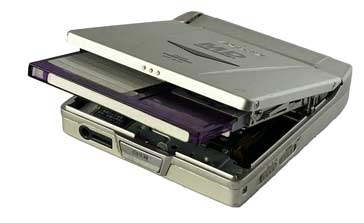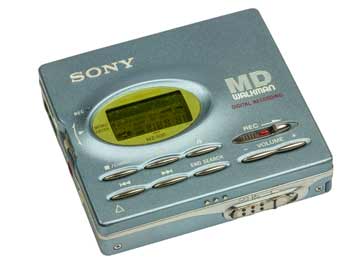Sony MiniDisc - what it is & how it works
Explore the inner workings of the Sony MiniDisc, delving into its storage format, recording capabilities, and the reasons behind its rise and eventual decline.
Sony MiniDisc Includes:
Sony MiniDisc - the basics
MiniDisc technology - how it worked
In the ever-evolving landscape of audio storage, the Sony MiniDisc, or Sony MD stands as a fascinating chapter.
Introduced in 1992, the Sony MiniDisc, MD promised a revolutionary alternative to cassette tapes, combining the portability of a compact cassette with the digital precision of a CD.

While ultimately overshadowed by later digital formats, the MiniDisc left its mark as a unique and innovative technology.
One of the main icons of this technology was the MiniDisc itself. Smaller than a CD, and protected like a 3¼inch computer floppy disc, these discs were available to record, and also as prerecorded read only discs with a whole music library available.
How the MiniDisc was developed
The compact audio cassette revolutionised the way music was consumed. Although introduced in the early 1960s, it was the Sony Walkman that sealed the success of the cassette.
However as other formats like the CD started to become more popular and digital technology was improving, Sony decided an equivalent of the cassette Walkman needed to be developed for the new digital age, but it had to be small and portable.
The result was the Sony MiniDisc. The development of the MD system actually started in 1987, but it was not until 1992 that the system was actually launched.
Despite its poor uptakee in some parts of the world, Sony stated their intention to cease MD production in February 2013 and the last of the Sony MD players were sold in March 2013 - this seems comparatively late considering that MP3 players, iPods and phones had long since taken over the market with stored and streamed music.
What is the Sony MD
Essentially the Sony MiniDisc is a disc based system that utilises a small disc, the essence of which might be thought of as being similar to a CD in some respects.
However the MiniDisc is much smaller, a mere 2.5 inches against the diameter of a CD which is 5.25 inches in diameter. Also the MiniDisc is housed within a protective plastic case which at the time it was launched was likened to an old 3¼ inch floppy disc.
A further difference between the CD and the MiniDisc is the the MD uses magneto-optical recording unlike CDs which use an optical method.

Also as the MiniDiscs are much smaller than CDs and this means that there capacity, at least for the basic versions is very much less.
To achieve a sufficiently long playback time, data that is recorded onto the discs is compressed using a scheme called ATRAC.
The MiniDisc players themselves came in a variety of formats. The most popular were the small portable devices. Like their cassette predecessors, these took on the name Walkman, i.e. MD Walkman, but in addition to this, there were also the familiar units intended for home based hi-fi and music systems.
Being a digitally based format, the quality was better than that which could be achieved using analogue cassettes, and also the audio quality did not degrade with time because the discs were not physically touched during playback unlike the cassette tapes where there was wear on the tape head and the tape itself.
Additional MiniDisc features
MiniDiscs offered more than just digital recording and playback. They incorporated a number of advanced features that enhance the ease of use and listening experience.
Digital Signal Processing (DSP : Some MiniDisc players incorporated DSP features like digital noise reduction and sound enhancement. These could significantly improve the sound, especially when wanting to become absorbed in the music.
NetMD: This advanced format allowed connecting MiniDiscs to computers via a serial cable, enabling digital music transfer and playlist creation. This feature echoed the way in which MP3 players and later the iPod would be able to download music from digitally stored files on computers.
MDLP (MiniDisc Long Play): Introduced later, MDLP offered extended recording times (up to 160 minutes) by utilising a higher ATRAC compression ratio. However, this came at the expense of some reduction in audio quality.
MiniDisc equipment formats
The main type of MiniDisc player that was bought was the portable player. These were typically smaller than the cassette Walkmans because the minidiscs wee smaller and more compact.
However in these days, the earphones or headphone used did not allow control of the controls like stop, play, fast forward, etc, so there was an attachment to enable this to be done.
These headphone adapters had the standard jack plug, and also a four pin connector mounted in the same moulding to carry the control signals.

These adapter cables also had a display in them so that the status of what was playing etc could be seen while the player was still in the pockets, etc.
In addition to the portable Walkman players, Sony also manufactured units to be incorporated into home systems. These might be the ones used to record music, and listen to it at home.
To try to gain industry-wide acceptance of the MiniDisc standard, Sony licensed the technology to other manufacturers, and a number of other companies sold MiniDisc units if varying types.
MiniDisc lack of success
While products like the cassette Walkmans were incredibly popular the MiniDisc did not achieve the same level of sales and the same iconic status globally.
The technology behind the system was very good and ahead of the competition, especially the digital compact cassette, DCC.
While the MiniDisc was very popular in Japan, and reasonably so in other areas of South East Asia it only met with limited success in the Europe, and especially the USA.

In many ways, the technology was surpassed by other developments. Recordable CDs became available, and then players such as MP3 players and iPods soon started to overtake the MiniDisc.
Also, the slow uptake of MiniDisc was attributed to the small number of pre-recorded albums available in the format.
Comparatively few record labels wanted to invest in yet another format, especially as CDs were still dominating the market.
A further disadvantage was the initial high cost of equipment and blank media. A further factor was that, home MiniDisc decks were less widely available, and most consumers used their portable MD devices to their hi-fi system in order to record and even play back.
Despite this, Sony launched over 100 models over the period when MD technology was available.
A Legacy of Innovation
Despite its commercial shortcomings, the MiniDisc left a lasting impact on the audio industry. It pioneered the use of magneto-optical storage for portable audio and demonstrated the viability of digital music formats. Today, a dedicated community of enthusiasts keeps the MiniDisc alive, preserving recorders and media and appreciating its unique blend of digital quality and physical interaction.
The Sony MiniDisc serves as a reminder of the constant evolution of audio technology. While it may not be the dominant format today, it stands as a testament to Sony's pioneering spirit and the ongoing quest for innovative ways to experience music.
More Audio Video Topics:
HDMI
SCART
DisplayPort
DVI
Loudspeaker technology
Headphones & earphones
Bluetooth speakers
Stereo sound
Microphones
Audio compact cassettes
Vinyl record technology
Digital radio
DVB television
Return to Audio / Video menu . . .


